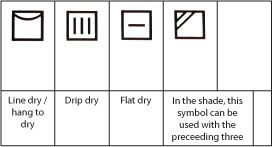I’m sure plenty of people have heard of Ariel’s campaign to wash at 30°C. This is a great way to save energy, as up to 90% of energy used in the washing process is taken up heating the water, so if the temperature is lower less energy is needed to reach it. The lowering of the washing temperature by just 10° reduced the amount of energy consumed by approximately 14%. This incentive is a positive to save energy, however the detergent companies have cleverly obscured the issue of the chemical ingredients within their products. More recently, Persil have developed a detergent that washes at 15°, which is all well and good, but who has a 15° setting on their washing machine?
Concentrated formulas have been developed to reduce packaging, space and energy when transported. Isn’t that wonderful? It’s a shame they forget to tell you that they pack these concentrated versions with fillers such as sodium sulphate. Also, consumers have difficulty measuring doses of the ‘normal’ detergents, which inevitably leads to overdosing with the concentrated formulas too. Standard detergents are also unlikely to biodegrade and contain phosphates, which consumers are currently paying for the removal of through their water bills.
So, any alternatives?
Eco detergents, for example Ecover or Bio D contain plant based surfactants and (usually) free of optical brighteners and phosphates. In using plant based surfactants, eco detergents have the ability to biodegrade in a matter of hours or days. These detergents can also wash at 30°C.
Avoid products with optical brighteners as these are made with the chemical stilabene, which can usually cause allergic reactions, effect hormones (nice!) and are toxic to fish.
Other, more unusual products exist in the form of Ecoballs or Soapods. Ecoballs are plastic balls that contain ceramic granules that ironises oxygen molecules in the water to wash clothes. They do not pollute water, fade or damage clothing; however can soften it (which my brother vouched for when he read!), are anti bacterial and can be used up to 1,000 washes! Soapods are a renewable resource that grows on sapindus trees. The shell of the fruit is placed in a canvas bag and into a normal wash. They are 100% biodegradable, allergy free and ensure colours stay bright and soft.
I also researched into care labelling (which if your reading this, I’m sure you read and follow the instructions, right?). It has been reported that over half of consumers (57%) always or usually read laundering instructions before washing a garment, a huge drop from 77% in 2003. There is generally a low to average level of understanding of garment care labels. Habit usually prevents consumers reading care labels, which are usually used as a guide rather than strict instructions.
The way in which garments are labelled, in relation to care, I find somewhat frustrating as they are incredibly vague yet ridiculously complicated at the same time. Though a mini investigation into my own wardrobe, I investigated the number of loads I was expected to separate my clothing into to achieve optimum washing results. In following the recommendations along with separation of colours, 21 loads were created! (There’s no way I’m spending my weekend doing that many loads!)
I also noted contradictions and errors within the labelling of my wardrobe; additional text not matching symbols, garments that can be machine washed as well as dry cleaned and dry clean and tumble dry symbols being mixed up.
The Home Laundering Consultative Council (HLCC) regulates the labelling system. Through research, I discovered that the 30° wash tub symbol is not a registered symbol by HLCC hence the additional text on care labels. I was shocked to discover this, especially with the increased coverage of washing at 30°. Also the only drying symbols within the HLCC are tumble dry or no tumble dry. Researching further, I discovered that within Japan and America there are a selection of drying symbols:

Japanese Natural Drying Symbols

American Natural Drying Symbols
This made me question the labelling system, to which I came to the conclusion that it is somewhat outdated. There is a definite case for further research into the application of symbols offered. Care labels also need to reflect the current situation and encourage consumers to re-think their laundering practice to save energy.
So, this is a summary of my first term on the course Fashion and the Environment. You may feel that this does not fit the design philosophy of the blog, but I think there are processes within garment laundering that definitely need a re-design.
We are helping many mums enter the self employed baby clothing market by supplying low cost care labels for the clothes. We will give advice on the materials and markings required for babies clothes and send you a sample pack of care labels printed to your design free of any charges. Just visit www.care-labels.co/free-care-labels-samples.html and get started on your new venture
ReplyDelete